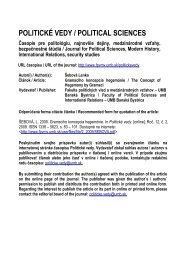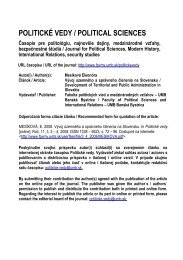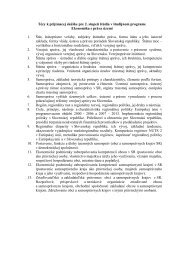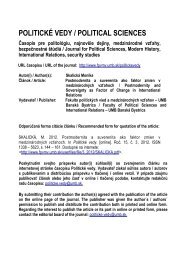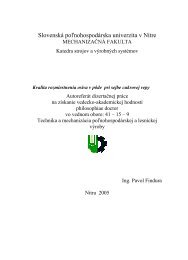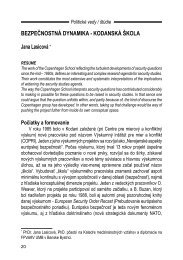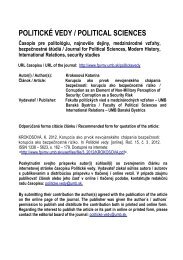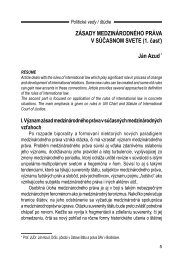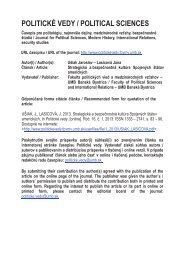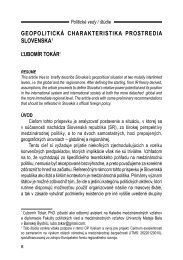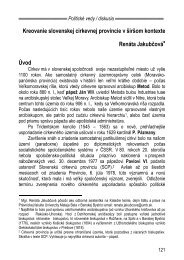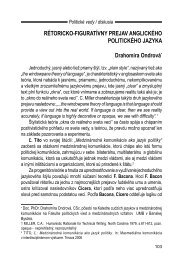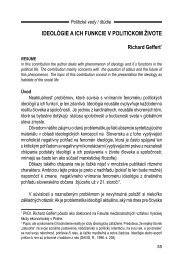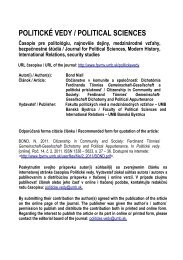MRAVNÃ VÃCHOVA V Å KOLÃCH NA SLOVENSKU A V ZAHRANI ÄÃ
MRAVNÃ VÃCHOVA V Å KOLÃCH NA SLOVENSKU A V ZAHRANI ÄÃ
MRAVNÃ VÃCHOVA V Å KOLÃCH NA SLOVENSKU A V ZAHRANI ÄÃ
Create successful ePaper yourself
Turn your PDF publications into a flip-book with our unique Google optimized e-Paper software.
1.2. Philosophy for Children (and Community of Inquiry)<br />
I think that one of the possibilities how to put this intention into practice could be the usage of<br />
methods and experience from the world gained through the moral education model known as<br />
Philosophy for Children (P4C), or its modification Community of Inquiry (CI). 1 Robert Fisher, in<br />
connection with the basic P4C ideas formulated at the end of 1960s by Matthew Lipman, stated that<br />
the aim of P4C is to develop in children the ability to go beyond the horizon of information they<br />
receive from texts not only in their literal meaning but also on the level of analytic and notional<br />
thinking. According to him we have to try hard to make children think and solve problems<br />
independently, critically and creatively. The aim of P4C is to encourage and develop these skills: to<br />
understand the text they read, to identify what they understand and do not understand, to be interested<br />
in what they read and discuss. Furthermore, it is about their ability to ask relevant questions, to<br />
develop mental abilities, to express ideas and hypotheses, to use imagination in their own thinking, to<br />
examine alternative ideas and explanations. At the same time, the purpose of P4C is to constitute<br />
assessment attitudes, judgements, ability to assess value of ideas, ability of self-assessment and selfcorrection.<br />
All these abilities are to be developed through cooperative activities. The means of<br />
reaching the aim is open group discussion on questions interesting for teenagers with the assistance of<br />
philosophy-conscious teacher (Fisher, 2001, s. 67 – 68). Nancy Vansieleghem says that Lipman based<br />
his philosophy concept on Socratic questioning. Questions are always connected with statements,<br />
terms analysis, validity, comprehensibility and reliability of argumentation. Philosophy and ethics<br />
offer the possibility to think autonomously applying several means that enable individuals to ask<br />
others or themselves. Thus we can doubt our deepest feelings, values and identities. Then the process<br />
becomes self-education and constitutes new ethics of thinking and acting. The aim is to articulate<br />
mutual understanding for the whole world via mutual dialog and understanding. This dialogue is<br />
symbolized by the transformation of the class into CI (Vansieleghem, 2005, s. 177 – 178). Matthew<br />
Schertz observes that CI is a dialogic form focused on constituting questions, which is a part of P4C<br />
and which enables students to get involved in philosophical discussions by asking questions and<br />
thinking of terms. Teacher stimulates and facilitates the philosophical discussion formulating various<br />
questions during the discussion, makes positions problematic, asks for explanations or offers counterexamples.<br />
Although the teacher leads the discussion, students determine the topic and formulate<br />
questions during dialogues. Continually, as they are acquiring this procedure, the role of the teacher is<br />
becoming less important. On the basis of his own experience, the author claims that students´<br />
philosophical questions enriched their discussions on science, history and literature. The influence of<br />
CI is shown also outside the philosophical discussions, e. g. in students´ mutual relationships and<br />
attitudes to education. In his opinion, CI is becoming an important means of moral education because<br />
it enables discussions on ethical and moral issues encouraging empathy and pro-social behaviour in<br />
the social context. P4C encourages a thinking and rational subject, which is desirable because it<br />
creates a solid basis for autonomous moral development (Schertz, 2007, s. 192 – 194). Karin Saskia<br />
Murris is of the opinion that P4C is an introduction to the higher level thinking and critical reflexion<br />
concerning methodology of all disciplines (Murris, 2008, s. 668). According to Laurance J. Splitter,<br />
the most basic feature is the fact that CI teaches children how to think and reason well, providing a<br />
kind of “vaccination” against manipulation and indoctrination, to which children are exposed and<br />
which they will come across when thinking and deciding about themselves and others (Splitter, 2007,<br />
s. 274). 2<br />
1 I will not deal with the moral education concept by Robert T. Hall and with the possibilities of its usage for<br />
needs of students at secondary schools in Slovakia, as I covered this topic in the past (Gluchman, 1996b, s. 422-<br />
423, 2008b, s. 144-151).<br />
2 World´s leading specialized magazines provide plenty of positive experience with these programmes in Ireland,<br />
Germany, Slovenia, the USA, Great Britain etc. (Calvert, 2007, s. 309–328; Russell, 2002, s. 141-153; Šimenc,<br />
2008, s. 323–336).<br />
286



